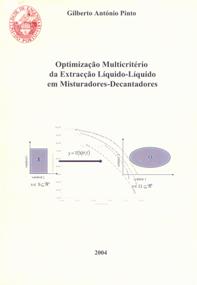
The main objective of the present work is an attempt to produce substantive evidence about the conceptual wealth of the solutions of a liquidliquid extraction problem within the framework of multi-criterion optimization, as compared to the more conventional single-objective stance. By using the weighed sum approach to the definition of the decision criterion, parametric optimization (i.e., defining the best operating conditions: residence time, agitation speed and phase flow ratio) is attained as well as significant information about structural optimization (i.e., defining the best flow diagram: number of stages, flow structure and recycle ratio).
As a case study for displaying this methodology, the solvent extraction of two chemically similar metais - zinc and cadmium, two species commonly found in ore leach liquors - was chosen, as well as the most common extraction equipment used in the metallurgical industry - the mixer settler combination.
The mathematical model representing the extraction stage was obtained by coupling two steady-state models described in the literature: the model developed by Ruiz (1985) and Padilla (1996) describing the hydrodynamic behaviour of the settling unit, and Guimarães' (1989) model describing the hydrodynamics and mass transfer in the mixer. Both models were restructured into a combined algorithm where the former received a whole new - and simpler but not less accurate - resolution structure and the latter - given the availability of the source code - was simply extended to accommodate two-component extraction and chemical reaction at the drop surface under diffusion controlled transport kinetics.
The computational code created for the settler was tested against the original authors' data as well as against fresh experimental data. A purpose designed-and-built experimental set-up was used to obtain detailed new data for the geometry of the dispersion band in the settler. In both instances, numerical results showed good agreement with experimental data.
At a later development stage, the mixer-settler algorithm was incorporated as an autonomous subroutine in the flow-sheeting simulator, SIMUL, developed by Durão (1988), in order to obtain proper design data for circuits combining several units in different topologies.
At the analysis stage, the sensitivity of the two opposed design criteria (purlty and recovery) to the operating conditions (residence time, agitation speed and dispersed phase hold-up), using, in succession, each one of these as a parameter. Three major conclusions became immediately evident: !i) the pposed effects of the hold-up on purity and recovery; ii) the strong sensitivity of short optimum residence times to agitation speed; iii) the ability of counter- current associations to dampen down variations of the relative weight of the two design criteria, eventually generated by market and/or environmental policy fluctuations.
Finally, global parametric optimization (i.e., without parameterization of any of the operating conditions) was performed, using a well-known multi-criterion optimization strategy with constraints, the Newton-Lagrange method.
The emerging results confirmed the previous analysis and brought forward: i) the wealth and breadth of the solutions, when compared with the more common single-criterion outlook; ii) the fact that multi-criterion optimization automatically incorporates sensitivity analysis and is useful to predict / avoid harmful effects of unavoidable departures of the implementation from the design specification as well as uncontrolled fluctuations of feed composition and flow-rate and / or market conditions and/or environmental policies.
